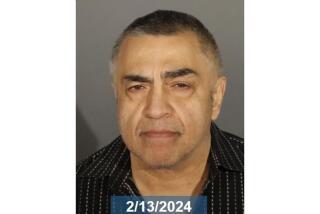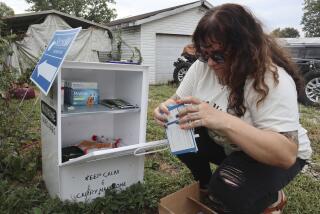The radical new way law enforcement in Virginia is approaching heroin overdose deaths
Reporting from Winchester, Va. — Tracy Cogle’s death was hardly a mystery. The 34-year-old mother was found slumped on the floor of her grandparent’s bathroom, a heroin-laced syringe nearby.
In years past, police would have conducted a fairly rudimentary investigation, taking a report and notifying relatives of Cogle’s demise.
But her 2013 death came amid a wave of overdoses in this rural nook of northwestern Virginia. And law enforcement agencies were fast learning that one heroin overdose usually meant many more would soon follow, related to the same bad batch.
Frustrated investigators decided to embrace a relatively radical approach: treat her death as a homicide and go after the dealer.
“People were dying left and right from this,” said Lt. Wally Stotlemyer of the Winchester Police Department, who leads the narcotics task force that investigated Cogle’s death. “We had to try something. And in a real sense, these were homicides, in their own way.”
Police took crime scene photographs and collected evidence, including the syringe and tin foil used to cook the heroin. They combed Cogle’s cellphone for clues and hunted for witnesses.
It led to an exhaustive 10-month probe in which investigators raced against the clock to identify the source of the drugs even as his deadly heroin claimed more lives. They would eventually dispatch informants 100 miles away, down an East Coast interstate dubbed “heroin highway” by police, to purchase drugs from the man they suspected in at least a half dozen overdose deaths.
Q&A Could Russian hackers mess with the U.S. election results? It wouldn’t be easy; here’s why »
Applying old-fashioned investigative tactics, such as basic forensics and dogged shoe leather, was rarely seen in overdose cases.
Stotlemyer’s 10-member regional narcotics task force was one of the first in the nation to investigate such cases as homicides, kick-starting a trend that seeks to hold dealers criminally responsible for their customers’ overdoses. Police and federal officials say the new approach was born partly out of desperation as they seek new ways to combat an epidemic that shows no signs of abating.
It remains unclear whether the new legal tactic is discouraging dealers, but at a minimum law enforcement officials say it is saving lives.
Heroin dealers make good targets for such cases because arresting a single supplier can have an immediate effect in decreasing a region’s heroin-related injuries and fatalities. Addicts prefer the strongest heroin they can find, so the narcotic has become increasingly pure and inexpensive, and is being combined with other powerful drugs.
“With meth and cocaine, you occasionally see an overdose or two,” said Dana Boente, U.S. attorney for the Eastern District of Virginia. “But with heroin, you get an entire bad batch and people die with greater frequency in groups. And that is why catching one dealer can have a broad impact.”
In August, for example,150 overdoses over a six-day period in Ohio were linked to heroin laced with a powerful animal tranquilizer.
That’s why federal prosecutors say they are seeking to bring more cases against dealers. Federal penalties for dealing drugs that lead to an overdose death or injury can be stiff -- a mandatory minimum sentence of 20 years.
Over the last few decades, narcotics detectives and death investigators rarely worked together. While police officers documented scenes and took reports on deaths, narcotics detectives worked separately, hunting for kingpins and major dealers as they had always done — building confidential informants, using wiretaps.
Narcotics detectives have begun to take more active roles in overdoses as heroin-related injuries and deaths skyrocketed across the nation. In 2014, more than 10,500 people died from heroin overdoses, an increase of nearly 80% since 2012, according to the U.S. Centers for Disease Control and Prevention.
The same spike was recorded in the five mostly rural counties surrounding Winchester, a city of 26,000 residents 60 miles west of Washington. The region tallied an average of 17 heroin overdose deaths between 2013 and 2015, up from an average of five during the previous six years, according to police and data from Virginia’s medical examiner.
And police say the statistics likely undercount the problem because it is not always clear that people taking multiple drugs died from the heroin in their systems. This year is on pace to continue the trend, investigators say.
How the 1981 assassination attempt changed Nancy Reagan »
Police and federal law enforcement officials looking into Cogle’s death knew the area was supplied by dozens of minor dealers who purchased their drugs from middlemen and top dealers, most likely in the Baltimore area. If they could climb that chain — starting with those who suffered overdoses — they might be able to arrest the top two or three suppliers of heroin to the Winchester area.
“There is a tremendous sense of urgency to identify the traffickers of these lethal drugs,” said Karl Colder, special agent in charge of the DEA’s Washington field office.
Moving quickly after an overdose is essential, investigators soon determined. So their first task in adopting the new aggressive approach was to convince emergency medical technicians and dispatchers to alert them to suspected overdoses so investigators could collect evidence at the scene or at hospitals.
In the best-case scenario, overdose victims would survive and could be interviewed. “We found that victims were very cooperative right after you save their lives,” said Jay Perry, a supervisory special agent with the Virginia State Police. After a few days, victims tended to be less willing to help investigators.
Even if an overdose were fatal, as with Cogle, investigators learned it was important to expeditiously tap into the emotions of friends and fellow users for tips and leads. Cellphones — and texts and calls between dealers and customers — also provided valuable clues.
It didn’t take them long to figure out how Cogle was getting her toxic elixir of heroin and fentanyl, a synthetic opioid painkiller that is often mixed with heroin to intensify the high. When she died on Nov. 17, 2013, she had fatal doses of both drugs in her system.
Combing through Cogle’s phone, police discovered a series of calls to a man known in her directory as “Charlie,” but the number was linked to a pre-paid “burner” phone with no subscriber information. Some of Cogle’s friends filled in the blanks, telling investigators that she had driven to Baltimore to meet Charlie to purchase a couple of grams of heroin.
They were still running down leads when another woman died of a heroin overdose in the Winchester area. Rita Livermore, 49, was found in her house. Investigators identified the person who sold Livermore three small bags of heroin for $100. He soon fingered his supplier: a man calling himself Charlie.
“It was getting out of control,” said Stotlemyer. “We could tell it was coming from Baltimore, but the dealers were smart, using ‘burner’ phones and dealing with known customers. We needed a break.”
That came when Baltimore County police arrested a drug dealer named Christopher R. Giles, and raided his townhouse and apartment. Police suspected he was a major supplier of heroin to addicts in Virginia and West Virginia. During searches, police recovered $60,000 in cash, marijuana, crack, heroin and more than a dozen cellphones.
Two of those devices had numbers matching the ones they had already linked to Charlie.
A bit of sleuthing revealed that Giles, now 28, was “the dominant name in the market of heroin sales from Baltimore to Winchester-area residents,” federal prosecutors wrote in court papers.
Giles, who had three felony drug convictions, sold about 4 pounds of heroin a month to customers in the Winchester area, police learned. He had a broad customer base with at least 200 clients and established himself as a one-stop shop for heroin, crack and cocaine — all distributed from a stuffed backpack in the parking lots of restaurants and near interstate highways. Informants told police that he was always friendly, that he dispensed his heroin with a smile.
Police and federal agents were steadily building their case when they got bad news: Giles had been released on bail.
Investigators had a strong case against Giles for the past overdoses, but they wanted to prove that he was “still actively dealing,” said Perry of the Virginia State Police.
So they dispatched several informants to surreptitiously purchase drugs. They met in the parking lots of fast-food restaurants and gas stations, all of the purchases recorded on hidden video cameras. “We gave him no wiggle room,” Perry said.
With their case nearly complete, investigators obtained a warrant for Giles’ arrest in September 2014. But it took a month to track him down.
They were too late for one user. Just days before they nabbed Giles in mid-October, Bryant White, 43, was found dead in his motel room.
Giles and his business partner, 43-year-old Warren Evans Jr., both pleaded guilty in federal court in Harrisonburg, Va., to dealing drugs that led to the injury or death of a user. As part of their plea deal, they admitted their heroin fueled at least six overdoses, three of which were fatal. Authorities suspect at least two dozen other people likely overdosed on the dealers’ drugs.
The men were sentenced to at least 25 years in federal prison.
Officials noticed an immediate impact. In the two months after the arrests, the region’s heroin overdose rate dropped from an average of about two a week to less than one. “We saved some lives,” Stotlemyer said. “No doubt about that.”
But the victory was short-lived. After two months, overdoses spiked again. A new dealer had moved into the region after Giles was put away.
Said Stotlemyer: “This never seems to end.”
Twitter: @delwilber
ALSO:
Tracking down guns used in crimes and terror attacks is still surprisingly low-tech
Aspiring agents learn from mistakes of FBI’s ‘shameful’ investigation of Martin Luther King Jr.
How these Brooklyn prosecutors work to get innocent convicts out of prison
More to Read
Sign up for Essential California
The most important California stories and recommendations in your inbox every morning.
You may occasionally receive promotional content from the Los Angeles Times.











